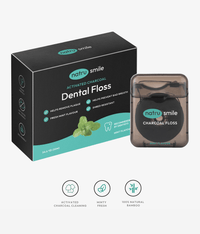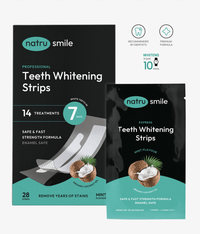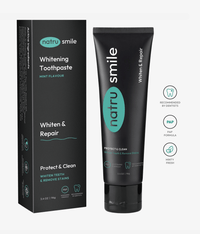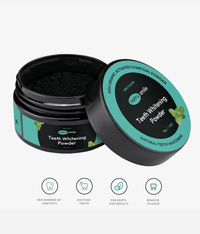
All products are certified by dental expert Dr. Greg Grillo
Invisalign is a popular orthodontic treatment that can help straighten teeth and improve your smile. With 14 million people as of September 30, 2022 having used the Invisalign system, it’s a testament to its effectiveness.
It consists of a series of clear, removable aligners that are replaced every two weeks or so as your teeth gradually shift into place. While Invisalign may be convenient and comfortable to wear, it also requires regular cleaning to keep it in good condition and prevent bacteria from forming on the aligners.
Read on for tips on how to clean Invisalign correctly, as well as tips for preventing build-up!
Cleaning Vs. Rinsing Invisalign Aligners
Cleaning vs. rinsing your aligners can be looked at with the analogy of washing a car. Cleaning would involve washing the car’s exterior with a soapy solution and water, while rinsing would simply be spraying down the car with water.
When it comes to cleaning Invisalign aligners, cleaning is an in-depth process involving using a soft-bristled toothbrush and specific cleaners to remove plaque and bacteria from your aligners. Rinsing is a simpler process that can be done daily with lukewarm water or sterilized saline solution.
While cleaning sounds much more in-depth, both are important for keeping your aligners in good condition.
Cleaning Invisalign Accessories
In addition to cleaning your aligners, you’ll want to also clean any accessories that come with the Invisalign system or that you’ve bought yourself. These include things like the remover tool and chewies.
The remover tool should be washed regularly with a soapy solution and water or sterilized saline solution. The chewies can be cleaned by soaking them in a bowl of warm water and mild dish soap for about 30 minutes before air drying them thoroughly.
What Are The Best Practices For Cleaning Your Invisalign?
Invisalign cost can get pricey depending on where you’re based and your treatment plan, so it’s important to take good care of them. Depending on how diligently you want to clean your aligners, you may find that a combination of methods works best for you. Here are some best practices you should be following:
Soak Your Aligners In Cleaning Crystals
Cleaning crystals are a great way to disinfect your aligners and remove any plaque or bacteria that have built up. They work by releasing oxygen, which helps break down the plaque on your aligners and freshens them up.
Simply rinse your aligners under tap water and put them into a container with warm water and one packet of cleaning crystals. Shake or stir the solution for 20 seconds to dissolve the crystals, and soak for 15 minutes or more. Shake or stir again and then rinse your aligners with warm water.
Doing this every few days can help keep your Invisalign aligners clean and fresh.
Brush Your Aligners Twice A Day
Using a soft toothbrush, gently brush your aligners every night. This will help remove any small particles of food or plaque that have built up on the aligners. It would help if you also cleaned them when they’re visibly dirty, so they don’t become discolored or harm your teeth. Make sure to rinse the aligners thoroughly after brushing to get rid of any residue left behind.
Keep Invisalign Trays In The Case
When you’re not wearing your aligners, it’s essential to keep them in the case they came with. Think of the case like a protective barrier: it will protect your aligners from getting dirty or damaged.
This helps prevent bacteria from growing on the aligners while they are stored. Plus, keeping them in the case helps keep them from drying out and warping, which can happen when they’re left out for too long.
Don’t Use Colored Or Scented Cleaners
It’s best to avoid using colored or scented cleaners on your aligners, as they can damage the plastic and leave residue behind. Not only that, they can make it unpleasant to put your tray back in as they’ll leave a bad taste in your mouth. Stick to clear, unscented, and mild cleaning solutions suitable for Invisalign cleaning instead.
Use The Right Type Of Cleaner
We've touched upon what not to use, so what should you be using for your Invisalign? Let’s take a look.
Soap And Water
The simplest and cheapest way to clean your Invisalign is with a mild soap (like hand or dishwashing liquid) and lukewarm water. Gently scrub the aligners with your fingers or a soft toothbrush to remove any dirt or bacteria that may have built up. Make sure you rinse off the aligners thoroughly before putting them back in your mouth!
Vinegar And Water
Vinegar is an effective disinfectant and can help remove any stubborn build-up on your aligners. To use vinegar for cleaning, mix equal parts of white distilled vinegar and lukewarm water in a bowl. Soak the aligners for 15 minutes before rinsing them off with lukewarm water.
Note: Do not use apple cider vinegar or colored vinegars, as these may stain the plastic of your Invisalign!
Baking Soda And Water
Baking soda is a natural cleaning agent that can help remove plaque and bacteria from your Invisalign. Mix one teaspoon of baking soda with two cups of water in a small bowl and stir until dissolved. Place your aligners in the solution for 15 minutes and then rinse off with lukewarm water before wearing them again.
Sterialigner
Sterialigner is the only at-home cleaning system specifically designed and endorsed for Invisalign. Unlike other surface cleaners, Sterialigner products take it a few steps further and remove 17 of the most common yeast, mold, and bacteria that build up on and in your aligners. It’s a more comprehensive cleaning solution that leaves them looking and feeling like new in just 3 minutes!
How To Take Care Of Your Invisalign Aligners
Before you even get to the cleaning stage, there are a few things you can do to ensure your aligners stay in good condition.
Avoid Eating And Drinking With Invisalign
Although it can be tempting to take a sip or a quick bite or two while wearing your aligners, you should avoid doing so. Food and drink can get stuck in the grooves of the aligner and cause it to discolor or become stained - making it more stubborn to clean.
Brush And Floss Before Wearing Your Tray
Brushing and flossing before you put your aligner in will help to remove any food particles or bacteria that could get trapped in the tray when it’s on. Since you'll be wearing your tray for long periods of time, your teeth and gums should be clean before you put them in.
Don’t Use Hot Water
Hot water can damage and warp the plastic of your aligners, which means you’ll want to avoid using it when cleaning. Instead, stick to lukewarm or cold water so as to not delay your treatment.
Avoid Smoking
Smoking can discolor Invisalign aligners and make them difficult to clean. If you’re a smoker, be sure to take out your aligners beforehand - you don’t want the chemicals and nicotine to destroy the structure of your Invisalign!
Don’t Leave Them Out Without Protection
As mentioned, if you’re not wearing your aligners, you’ll need to keep them in their case or in a sealed container. This will prevent dust and other particles from getting stuck in the grooves of the aligner and causing bacteria build-up.
How Often Should You Clean Your Aligners?
It’s recommended to clean your aligners every day (ideally twice a day) and preferably before inserting them into your mouth. However, deep cleaning can be done less frequently, at least once a week.
Putting this into practice will help prevent plaque build-up and reduce the risk of gum inflammation or other dental problems. After all, Invisalign goes into your mouth and can contribute to the build-up of bacteria if not cleaned properly.
Are There Any Cleansers To Avoid?
There's a few simple rules to keep in mind when it comes to cleaning Invisalign - avoid harsh, colored, and abrasive cleansers or substances. Here’s a quick list of things you’ll want to avoid:
- Abrasive cleansers
- Toothpaste with baking soda or similar abrasive ingredients
- Bleach or chlorine-based products
- Any type of alcohol, including hand sanitizer and rubbing alcohol
- Whitening strips or gels
Using any of these products can cause discoloration or damage to your aligners.
Read on to learn more about cleaning your Invisalign and get your questions answered!
How Do You Clean Dirty Invisalign?
When your Invisalign aligners become dirty, it’s important to clean them as soon as possible. Here are the steps you can take:
- Start by rinsing the aligners in lukewarm water for a few seconds. This will remove any food particles or other debris that may be stuck on the aligner.
- Fill up a cup with warm water and add two drops of mild dish soap or liquid hand soap into it.
- Swish the aligners around in the soapy water for about 30 seconds, making sure to get into all of the crevices.
- Rinse off the aligners under lukewarm running water until all of the soap is gone.
- Finally, use a soft toothbrush with plain water to gently scrub away any remaining debris or plaque build-up on your aligners, and then rinse them one last time before putting them back in your mouth.
After a basic clean, you should also use specialized cleaning kits that are designed specifically for Invisalign. These kits usually come with a special cleaning solution, tablets, and/or wipes to help remove plaque and bacteria from your aligners. Just make sure to follow the instructions on the package for best results!
Is It Okay To Clean Your Invisalign With Toothpaste?
It’s generally not advised to use toothpaste to clean your Invisalign aligners. Most toothpastes contain abrasive ingredients that can scratch and damage the aligners, leading to a poor fit and even discomfort when wearing them.
If you really want to use something other than plain water or specialized cleaning kits for your Invisalign, try using a mild liquid hand soap instead, as it won’t cause any scratching or damage.
What Is The Best Method To Clean Invisalign?
A study published in the journal of Clinical Cosmetic and Investigational Dentistry looked at the growth of dental plaque on removable orthodontic aligners after using different cleaning methods.
They found that between (1) running water, (2) using effervescent tablets with sulfate crystals and sodium carbonate and brushing, and (3) brushing with toothpaste, using a dissolvable substance and brushing was the most effective.
While you’ll want to always rinse and clean your aligners in those other simpler ways, using cleaning crystals and a cleanser like Sterialigner and a soft-bristled toothbrush is the best way to clean them.
Can I Clean Invisalign With Mouthwash?
Mouthwash can be used to clean Invisalign, but it's important to use a natural mouthwash that doesn't contain harsh chemicals or alcohol. Natural mouthwashes are generally considered safe for cleaning aligners, though they may not be as effective as other methods.
What Should You Not Clean Invisalign With?
Avoid using any harsh chemicals or abrasives on your Invisalign. This includes bleach, alcohol-based solutions, and other strong cleaning agents. Additionally, you should never use hot water as this can warp the aligners and affect their shape and fit.
Does Listerine Clean Invisalign?
Listerine’s non-alcoholic Zero mouthwash is safe to use for cleaning Invisalign. However, it should be used in combination with other methods, such as brushing and rinsing with water.
Do I Really Need Invisalign Cleaning Crystals?
Invisalign cleaning crystals are not necessary, but they can be helpful to keep your aligners looking and feeling their best. They're designed specifically for Invisalign and help to remove bacteria, plaque, and food particles much better than other solutions.
Does Hydrogen Peroxide Damage Retainers?
Hydrogen peroxide can damage retainers by causing discoloration and weakening of the plastic material, which will affect the fit of your aligner. Once you put your retainer back into your mouth, it can also affect your enamel and gums. For this reason, you should never use hydrogen peroxide to clean your retainer.
Why Does Invisalign Turn Yellow?
Invisalign can turn yellow due to a build-up of plaque and tartar, as well as prolonged exposure to items with strong pigments, such as certain foods and drinks. Regular cleaning with natural solutions or Invisalign cleaning crystals can help to prevent this discoloration from occurring.










